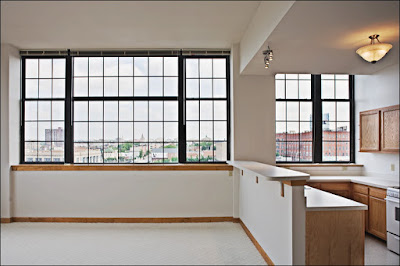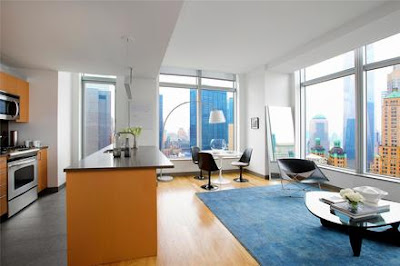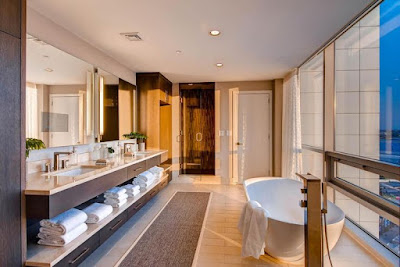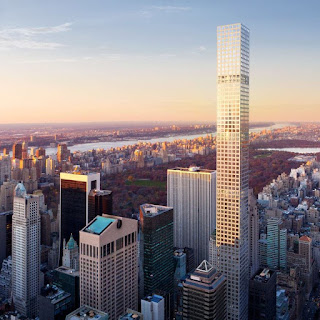Last week I reviewed student projects at the local architecture department. One half of the projects dealt with a dis-invested community in Baltimore with most of the design task involving housing. The other half of the projects were part of a design competition in a community in Los Angeles around a museum and a community center.
The students with the civic project designed interesting structures and created existing places in the community. The ones with the residences, not so much. Essentially, they recycled rowhouses and apartment buildings of a kind that would have looked outdated and unimaginative in the seventies and eighties of the last century. Brick walls with small punched out windows, double loaded corridors, surface parking, more attention to traffic than to floor plans and elevations.
![]() |
| Gehry New York |
What happened here? A colleague who was with me on the jury observed afterwards, "designing residential architecture is difficult." As one who has done townhomes, highrises, affordable apartments, luxury condos, renovations and new construction, I have never thought of it that way, but on second thought, I have to agree.
The students may have been stumped by interviews with residents who wanted no real change in their community. The mostly conservative architectural attitude in Baltimore provides only a small sampling of truly innovative new housing from which to take cues. Generally, though, architecture for homes and apartments is a bastion of architecture that seems to resist innovation. This is unfortunate, for the way people organize themselves as a community has changed drastically, both inside the housing unit and in the community at large, even though the basic needs of sleeping, eating, and hygiene remain largely consistent. There are several changes affecting how people live.
First, there are demographic changes: More than ever the urban household is not populated by the standard family, father, mother, and children, but is headed up by singles. In many cities households without children outnumber the ones with children. These trends are fed by the two strong cohorts of the aging baby boomers and the underemployed millennials. Both groups are looking for urban accommodation different from the suburban American dream of the past. With the trend towards the more expensive urban living, home-ownership is down and rentals are up.
An estimated 351,000 multifamily units were started in 2014, up nearly 14% over 2013 and more than double the 6.6% growth rate for total housing starts last year, according to the National Association of Home Builders. (Source)
Then there are cultural shifts. Increasingly an apartment or condo building is not just an assembly of dwelling units but a place where the sharing economy manifests itself in its many new facets. There are live-work units that are expressions of the new ways people earn a living, co-ops and community land trusts and any number of ways to address the affordability issue. With cultural and ethnic diversity come many different ways for adults to live together. Then there is the desire for place-making, community, and interaction that drives the trend to urbanity overall but also expresses itself inside apartment and condo buildings in the form of opulent common amenity spaces. These spaces are trying to turn living into an experience and allow communal interaction between the residents in gyms, office spaces, in-house bars, media centers and the like. Luxury apartments aim for a competitive advantage by featuring so many amenities that it seems as if the goal is to never have to leave the building.
![]() |
| Open floor plans: Gehry NY |
Then there is density. The global trends of urbanization require accommodation that is different from the repertoire that has been built for nearly a century: The three story walk-ups, double loaded corridor tower slabs, and the variations of the rowhouse aren't enough to satisfy the shifted demands. The latest edition of urban housing models, the "mixed use" structure with four or five story wood stick-framed apartments sitting on a concrete podium with smatterings of retail below is more a response to what the code allows than a response to the density issue, even though it is only a cheaper re-cast of a mixed use building that has been standard in European cities for a long time. Global urbanization also requires more sustainable structures not only in terms of how much space housing takes up but how much energy it uses, (it should produce energy, instead!) how resilient it is against climate change and what its transportation footprint is.
Finally, there are the shifts in the economy which have made many industrial, warehouse, and office buildings in former manufacturing hubs obsolete. Instead of tearing those often beautiful buildings down, the creative re-use has become an art form that shifted the paradigm of residential design of urban apartments. The shift is largely driven by the DNA of the industrial structures with their large window walls, ample floor heights, wide open floor plates and artifacts that provide the sought after authenticity. The adaptive re-use aesthetic has become a trend to the point that shortages of genuine warehouses have resulted in the construction of brand-new warehouse-style apartment buildings featuring "loft style" apartments with those large windows with the many mullions, salvaged fire doors installed like sliding barn doors, polished concrete and all the other paraphernalia of a reinvented industrial simile.
So, with all these trends, what should housing design for the future look like?
Some will be an extrapolation of changes that have taking place for a while, partly stemming from technological advance and partly from cultural change. For example, larger bathrooms finally have taken the small, hidden Victorian "water closet" in which the dark secrets of the human body lurked in unhappy repression and turned it into a bright and friendly space to enjoy the body. This is a change driven as much by ADA regulation as by a different attitude towards our bodies that has brought about a flood of modernized bathroom objects and accessories. The shower for two, the claw foot tub and the two sinks for him and her have turned into sales features. Even the view (out) is in now.
Another example are the historically secluded kitchens in which the housewife toiled until she was ready to present an opulent meal. Kitchens have grown and been opened up to allow communal gathering and potentially group cooking and even consumption in the same place. The trend to commercial appliances and large scale is a bit comic at a time when so much food is bought prepared requiring minimal prep work in the kitchen.
![]() |
| The lavish bathroom. Silo Point Baltimore |
Harder to crack is the paternalistic US expectation to have a "master-bedroom" in each house and dwelling unit. One would imagine the demographic and cultural changes would result in a more even distribution of sleeping places in recognition of the fact that typical households neither know a master nor are they headed off by couples sleeping in matrimonial beds. But just as real estate clings to the Colonial style, it is stuck with the master bedroom cum-bathroom-suite as an example of the essentially conservative character of residential architecture.
Change comes the easiest if it is just skin-deep but even the exterior envelope of housing is slow in change. Apartment and condo buildings were the last to say good bye to the monotony of punched out windows in a brick or stucco facades in favor of the curtain wall and glass facades that long have conquered many office and institutional buildings, but cost is a severe restriction. The adaptive reuse craze has made brick facades with large windows popular once again.
![]() |
Loft chic and open kitchen in an affordable unit. Printers Square, Baltimore
(photo and architect: ArchPlan Inc.) |
Change often emanates from the luxury segment. That was true for most industrial building adaptations if one ignores that it was poor artists in Soho that first popularized the loft. But then expensive condos adopted the style long before it became acceptable for affordable housing as well.
Sun-flooded bathrooms, kitchens with stainless steel appliances, industrial chic, tall ceilings, and the flexibility of loft-style apartments trickled their way from Home and Garden to HUD. Especially when it comes to affordable housing, though, what works for corporate headquarters, show-piece museums or Ivy League academic landmarks cannot easily be exported into a field where folks have to pay the bill via monthly rent checks coming from a largely stagnant income.
That leaves mega kitchens that could cater for a midsize convention to the suburban McMansion or to the multi-million dollar urban penthouse, which leads us straight to New York City.
For a review of new trends in urban residential design, New York City is a good laboratory, even though it is so special and unique. Unlike Los Angeles or Phoenix it is a city that can grow only upwards and not sideways, a condition which will eventually be the fate of any sustainable metropolis. New York is also representative of the country's extreme income bifurcation. It has massive public housing holdings and a rich history of innovation in public housing. It also has the most expensive apartments and condos in the nation.
![]() |
| Vinoly Tower NYC |
The boom for inner city housing has made New York a testing ground for new trends in urban living and hints of innovations that address residential density in the city with the longest history of density housing in the nation.
It was here where in 2004 with New Housing New York a competition was launched with the goal of finding new ideas, especially for affordable housing.
As the ArchNewsNow website correctly observed on occasion of the competition:
One of the major challenges facing most metropolitan centers in the world is affordable housing. It is not a new challenge by any means, but the search for solutions has changed radically since the days of tenements and gargantuan public housing complexes. There have always been issues such as zoning, density, construction costs, and design quality – and let's not forget NIMBY-ism (not-in-my-backyard) – when it comes to affordable housing. Contemporary urban centers now must deal with additional considerations such as sustainability and accessibility.
Nowhere is this more evident than in New York City. Last fall, the "New Housing New York" design ideas competition was launched to generate new ideas in affordable and sustainable housing design for housing production in the city. It was initiated by the City Council in cooperation with the American Institute of Architects (AIA) New York Chapter and the City University of New York. It was developed in partnership with the NYC Department of Housing Preservation and Development, the NYC Department of City Planning, and the NYC Department of Buildings. A co-sponsor of the competition is the New York State Association for Affordable Housing (NYSAFAH). (ArchNewsNow)
Having a competition is one thing, building housing another. The two step process wound its way into 2007 and this announcement, with Phipps-Rose-Dattner-Grimshaw (PRDG) as the winning architect-developer team of New York City's first juried design competition for affordable and sustainable housing. The winning Via Verde project was finally completed in the Bronx in 2012. The Metropolis Magazine described the project in its April 2013 edition:![]() |
| Via Verde, Bronx NY. Phipps-Rose-Dattner-Grimshaw |
The final design by Dattner Architects and Grimshaw Architects closely follows their competition entry. It includes 151 units of affordable rental housing, 71 units of co-op housing, and 7,500 square feet of ground level commercial retail and community space. Housing is divided into three linked structures that rise from 6 to 20 stories and wrap around a central, landscaped courtyard.
Via Verde, with its cascading roof gardens and facade of fiber-cement, aluminum, and wood panels and perpendicular sun screens stands out among the other brick buildings and towers in the neighborhood. It is also an example of a creative approach to the process of affordable housing design and development in New York, one that as many hope, will portend well for the future.
Of course, the headline grabbers on NYC's rapidly changing skyline are the luxury scrapers, the "mansions in the sky" as AngryArchitect called them in a piece on Architizer. Those towers designed by Gehry, SHoP, Vinoly, Potzamparc and other members of the architectural "elite" represent a truly new form of urban housing. But are these towers really innovative contributions to urban living except for their shape and skin?
The New York Times wrote about the Gehry New York:
...as the tallest luxury residential tower in the city's history, it seems to epitomize the skyline's transformation from a symbol of American commerce to a display of individual wealth. Mr. Gehry has accomplished the finest skyscraper to rise in New York since Eero Saarinen's CBS building went up 46 years ago. And like that tower, and Philip Johnson's AT&T ...building after it, 8 Spruce Street seems to crystallize a particular moment in cultural history, in this case the turning point from the modern to the digital age. The building's exterior is made up of 10,500 individual steel panels, almost all of them different shapes, so that as you move around it, its shape is constantly changing. And by using the same kind of computer modeling that he used for his Guggenheim Museum in Bilbao, Spain, more than a decade ago, he was able to achieve this quality at a close to negligible increase in cost. NICOLAI OUROUSSOFF
It
![]() |
| Potzamparc South of Central Parc, NYC. |
is clear that shape and skin are the main assets of the Gehry tower. No small feat if it makes a residential building a landmark in the skyline, an accomplishment achieved through systematic use of digital production directly from the drawing into manufacturing which avoids precisely what made traditional residential towers so dull: the endless repetitive patterns of window and wall or the uniform sameness of the glass wall. The interior units are not as innovative except that this may be the first residential tower ever offering bay windows on the 70th floor (or any other apartment behind the undulating facade).
Vinoly's 432 Park does quite the opposite. It takes repetition to the level of virtue. As The Real Deal reviewer James Gardner writes in his review:
Recalling a conceptualist sculpture by artist Sol Lewitt, it rises up as a sequence of perfectly square modules along its entire height, without any of the distinction between base, shaft or summit that is the norm with more traditional skyscrapers. Other than what looks to be two-story mechanical cores placed at intervals every 12 floors, there is nothing to give a sense of scale to the building. The sense of pure geometry, the almost polemical denial of scale, only enhances the sense of immensity.
The New York Magazine isn't so friendly. Justin Davidson judges the project this way:
Viñoly has designed a genuine clunker for 57th Street, an unrelenting concrete grid of ten-by-ten-foot openings like so many stacked cubbyhole units. This wouldn't be so bad, except that the tower will soon slap against the sky at almost 1,400 feet, making it temporarily the tallest residential building in the Western Hemisphere.
Ultimately, the Vinoly tower may offer little to the challenge of living tomorrow besides for being tall, impossible to miss in New York's skyline, and offering fantastic views.
About life in the tower, or rather the view from below, Justin Davidson says in the New York Magazine in reviewing One57, Portzamparc's tall and super-expensive oeuvre:
That's us down there—silent, flitting specks looking up at the homes of aerial overlords....The plutocratization of the midtown skyline is just getting under way.
It's hard to imagine how high the ceilings would have to be, how unusably glossy the kitchen, or how noiseless the air conditioning to make an apartment here feel like a good deal. At these financial altitudes, even an ordinary structural element feels like a ripoff. A concrete column as thick as an old-growth oak stands in the corner of the living room, holding up the building but obstructing the view. Another looms at the entrance to the master bedroom, making the approach seem vaguely ominous.
The main innovation these select examples offer is that they exist at all. Slender towers of this size soley devoted to housing are a novelty that had its most widespread application in Vancouver where it has become the most common form of urban living. In the form it has reached New York, Atlanta, Austin or Denver, the innovation is not that they provide a common housing solution but mostly the elite pleasure of looking down and looking out, maximized through the advances of glass facades.
![]() |
| Residential curtain wall, the Zenith, Baltimore |
As such the full glass facade on the residential building has become less a symbol of architectural advance and more an expression of power in the same way as a house on a seashore cliff or on a mountain-slope with a huge picture window is a symbol of power.
The interior spaces play second fiddle to the view. As such they are trite and banal, even in the condos that cost $50 million dollars and more. Even the most fantastic view will become tiring, though if it can be had in spades. Those full glass facades may be like bathing in chocolate or having sex all day, too much of a good thing. Corbusier understood this when he sometimes offered only a narrow horizontal slot to control the view out and the light coming in.
Which leaves us with the loft units as the most innovative interior change in housing, an innovation born from flexible spaces combined with a lack of resources. It is the loft unit that has brought us the mezzanine loft with a bedroom on an upper level open to the living room below. It is the loft unit that due to the large depth has brought us a galley kitchen in the dark spaces in back and the large open space well lit by gigantic industrial sized windows that can conform to any style of living.
![]() |
The fake warehouse: Remington Row, Baltimore
(photo: ArchPlan Inc.) |
Another innovation can be found on the other end of the spectrum, the micro unit. It too has a long history in New York, even before it was called by that name. It responds to the poverty of resources that afflicts many residents in large cities by drastically reducing the size of everything, a strategy that the rear dwellings of urban apartment blocks took already in early industrialization in metros like Berlin and New York. These Minis of architecture derive their sex appeal by being charged up with the latest gadgets, just like the automotive Mini. The statement that is made by someone buying a Mini, a Fiat 500 or a Smart car, really is just a gesture that doesn't solve urban mobility problems at all. Equally, micro units aren't that affordable after all, and appear to be little more than a fad for yuppies who love to make a statement.
Yet, just as the Pope's small Fiat made a statement amongst the convoy of secret service SUVs, tiny micro-units look incredibly smart and more appropriate than the New York Penthouse units on the 80th floor which cost so much that an average American would have to work 1,538 years to earn the amount of the list price.
Klaus Philipsen, FAIA
edited by Ben Groff J.D.
Residential Futures, ULI Discussion Paper
The $100 Million View: SHoP's Skinny Skyscraper Formalizes The Rich-Poor Divide








